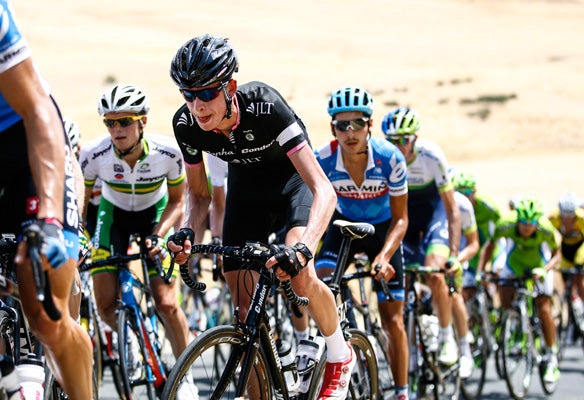
Riders from Rapha Condor JLT are well practised at riding in hot conditions and spending a long day in the saddle. Here's thirteen top tips to enjoying the Etape du Tour rather than enduring it.
-
Train, train and train some more says team leader Kristian House
As with most things, preparation is the key. Regular bike rides are essential: a few months before the event focus on quality, shorter rides at least three times per week, moving to at least two long rides a week (of four hours or more) with five weeks to go. Stick to these guidelines and it will make the difference between enjoying and enduring the day.
-
Former Tour de Korea winner Mike Cuming advises "practise seated climbing"
The Etape is unusual in that the climbs can be hours long, so practise steady, paced climbing in the saddle. Make sure your body position and fit on the bike is appropriate for this.
-
"Good shorts and chamois cream" – Kristian House
Getting saddle sore is miserable ... and avoidable. Splash out on good shorts if nothing else and use chamois cream – trust me.
-
Pace yourself says Ed Clancy
Events such as the Etape last many hours and the last few hours WILL be tough. Remember this at the start. If you have energy to use in the last hour, then go for it, but if you blow early it will be tough to finish, so sit behind as many people's wheels as you can (this will drag you along) and enjoy the day.
-
Team manager John Herety - "Eat and drink little and often"
If you are riding steadily, you don't need large amounts of food. In fact, eating too much will stop you absorbing fluids and dehydration will get you long before low fuel levels do. Regular bites of a cereal bar – maybe a nibble every 20 minutes or so and a full bottle of water an hour – will be about right. More water will be needed on the long climbs.
-
"It is all about lower gears" according to sprint ace Felix English
Take lower gears than you think you need. There is nothing worse than not having low enough gears. You either suffer badly as you try not to fall over or are forced to walk. Triple chain-sets are good for this as well as a very big sprocket at the back. Look for a compact 50-34 chainset or fit a 12-27 or 12-28 cassette. If you are unsure pop to your local specialist bike shop.
-
Kristian House - "find a group"
On the Etape, there are people around you all day. Staying behind them massively reduces your energy expenditure so take advantage of this – although remember to leave plenty of space on the fast descents.
-
Sunscreen and a cape advises Team Manager John Herety
The weather in the mountains changes quickly. Make sure you have plenty of sunscreen on (you will be out there for many hours) and take some waterproof clothing. Even if it doesn't rain, the descents from high altitude can be very cold. Don't put sunscreen on your forehead as it can mix with sweat and run into your eyes and sting!
-
Do it in company - Ed Clancy
It is supposed to be fun and not a race. Go with friends if you can, enjoy the day, the scenery, the crowds and the atmosphere and experience it all together.
-
Make post-race plans – John Herety
Make good plans for meeting up after the event. Mobile phones may not work well and there will be many thousands of people looking to do the same thing. Advanced planning for when you are knackered will pay dividends.
-
All rounder Graham Briggs advises "low cadence training."
I'm not a natural climber but I still need to get over the big hills during stage races. First fit a cadence sensor to your bike. You should be riding at around 90 rpm on most rides, that's general better for climbing but a great way to simulate the force required for steep gradient is by lowering your cadence to 60-70rpm and use a harder gear. Try alternating 60 seconds at 60 RPM and then then recovery in an easier gear at 90 rpm. Do this a couple of times on your ride.
-
Don't get in the junk training trap says Kristian House
Fitness comes from your body adapting to training stress and rebuilding itself stronger during recovery. The number one priority is consistency in training so little and often is better than daily and really short rides we call "junk training" that leaves you over tired during the week. Junk training can also come from daily commuting and racing off from every traffic light. Ease up on your short rides to work, try an easier gear and spinning more. Don't race to every red light and haul on the brakes, stopping and starting all the time puts lots of pressure on your knees.
-
"Get a feel for riding positions" says sprinter Felix English
Being on the bike all day is going to leave you feeling tired. Switch your position around during the ride, riding on the tops (the flatter straight section of the bar) when climbing and move onto the drops when descending. Do a few training rides and practise riding in various position so you feel confident and get a feel for handling in each of the positions.
Riding on the drops: when descending or driving a faster pace on the flats have your hands in the handlebar drops for greater aerodynamic efficiency. One of the easiest ways to present a smaller frontal area to the wind is to bend your elbows; this will helps to flatten your back and expose less of your chest.